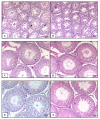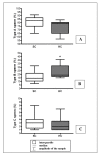In utero protein restriction causes growth delay and alters sperm parameters in adult male rats
- PMID: 21702915
- PMCID: PMC3141647
- DOI: 10.1186/1477-7827-9-94
In utero protein restriction causes growth delay and alters sperm parameters in adult male rats
Abstract
Background: Recent studies have supported the concept of "fetal programming" which suggests that during the intrauterine development the fetus may be programmed to develop diseases in adulthood. The possible effects of in utero protein restriction on sexual development of rat male offspring were evaluated in the present study.
Methods: Pregnant Wistar rats were divided into two experimental groups: one group treated with standard chow (SC, n = 8, 17% protein) and the other group treated with hypoproteic chow (HC, n = 10, 6% protein) throughout gestation. After gestation the two experimental groups received standard chow. To evaluate the possible late reproductive effects of in utero protein restriction, the male offspring of both groups were assessed at different phases of sexual development: prepubertal (30 days old); peripubertal (60 days old); adult (90 days old). Student's t-test and Mann-Whitney test were utilized. Differences were considered significant when p < 0.05.
Results: We found that in utero protein restriction reduced the body weight of male pups on the first postnatal day and during the different sexual development phases (prepubertal, peripubertal and adult). During adulthood, Sertoli cell number, sperm motility and sperm counts in the testis and epididymal cauda were also reduced in HC. Furthermore, the numbers of sperm presenting morphological abnormalities and cytoplasmic drop retention were higher in HC.
Conclusions: In conclusion, in utero protein restriction, under these experimental conditions, causes growth delay and alters male reproductive-system programming in rats, suggesting impairment of sperm quality in adulthood.
Figures



Similar articles
-
Short- and long-term reproductive effects of prenatal and lactational growth restriction caused by maternal diabetes in male rats.Reprod Biol Endocrinol. 2011 Dec 6;9:154. doi: 10.1186/1477-7827-9-154. Reprod Biol Endocrinol. 2011. PMID: 22142502 Free PMC article.
-
Functional and morphological reproductive aspects in male rats exposed to di-n-butyl phthalate (DBP) in utero and during lactation.J Toxicol Environ Health A. 2010;73(13-14):972-84. doi: 10.1080/15287391003751760. J Toxicol Environ Health A. 2010. PMID: 20563931
-
NTP technical report on the toxicity studies of Dibutyl Phthalate (CAS No. 84-74-2) Administered in Feed to F344/N Rats and B6C3F1 Mice.Toxic Rep Ser. 1995 Apr;30:1-G5. Toxic Rep Ser. 1995. PMID: 12209194
-
Neonatal estrogen exposure of male rats alters reproductive functions at adulthood.Biol Reprod. 2003 Jun;68(6):2081-91. doi: 10.1095/biolreprod.102.010637. Epub 2003 Jan 8. Biol Reprod. 2003. PMID: 12606459
-
Alterations in male rats following in utero exposure to betamethasone suggests changes in reproductive programming.Reprod Toxicol. 2016 Aug;63:125-34. doi: 10.1016/j.reprotox.2016.05.021. Epub 2016 May 28. Reprod Toxicol. 2016. PMID: 27247242
Cited by
-
Gestational and lactational exposure to gossypol alters the testis transcriptome.BMC Genomics. 2020 Jan 17;21(1):59. doi: 10.1186/s12864-020-6487-2. BMC Genomics. 2020. PMID: 31952482 Free PMC article.
-
Accelerated aging of reproductive capacity in male rat offspring of protein-restricted mothers is associated with increased testicular and sperm oxidative stress.Age (Dordr). 2014;36(6):9721. doi: 10.1007/s11357-014-9721-5. Epub 2014 Oct 30. Age (Dordr). 2014. PMID: 25354645 Free PMC article.
-
Fetal Programming Effects of a Mild Food Restriction During Pregnancy in Mice: How Does It Compare to Intragestational Ghrelin Administration?Reprod Sci. 2021 Dec;28(12):3547-3561. doi: 10.1007/s43032-021-00574-7. Epub 2021 Apr 15. Reprod Sci. 2021. PMID: 33856666
-
Maternal energy insufficiency affects testicular development of the offspring in a swine model.Sci Rep. 2019 Oct 10;9(1):14533. doi: 10.1038/s41598-019-51041-y. Sci Rep. 2019. PMID: 31601864 Free PMC article.
-
Effects of Parental Dietary Exposure to GM Rice TT51 on the Male Reproductive System of Rat Offspring.Biomed Environ Sci. 2016 Apr;29(4):267-74. doi: 10.3967/bes2016.034. Biomed Environ Sci. 2016. PMID: 27241737 Free PMC article.
References
Publication types
MeSH terms
Substances
LinkOut - more resources
Full Text Sources
Medical

